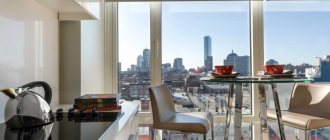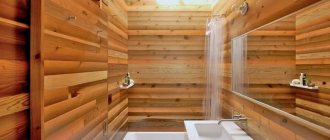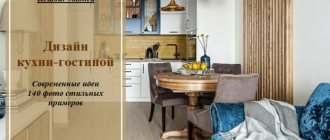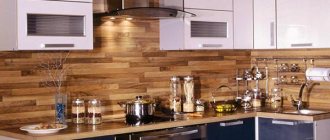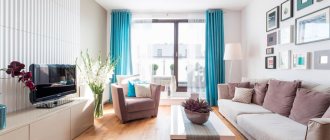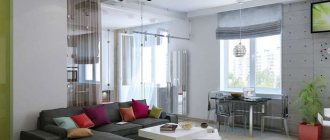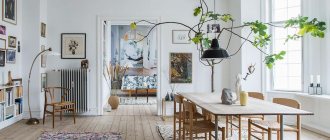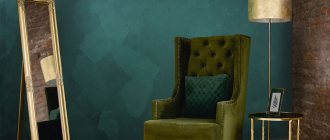Walls are important elements of the interior, occupying large spaces and serving as a backdrop for furniture, paintings, other useful items and decorative elements. But everything can change radically if you make a bright accent on the wall, which occupies the main place in the room, which is the object of everyone’s attention and the calling card of the entire house. In most residential homes, this is the living room. Such a wall is called an accent wall; it differs significantly from all other walls in its color, texture, pattern, and image.
Placing the right accents by highlighting one wall is a simple and very common way to create an original interior.
The emphasis is on the wall that first comes into view when a guest enters the room; there cannot be two or more of them. The first 15 seconds in a new room become the main ones for the perception of information; all subsequent impressions will only be superimposed on the already developed judgment. They don’t always finish the entire wall, sometimes a part of it is enough, it all depends on the size of the room. According to psychologists, a properly accentuated workspace disciplines, and an accentuated place for rest allows the body to recover.
Basic rules for creating an accent wall in the living room
There are a large number of design techniques for creating accent walls, which solve a number of problems:
- This is an opportunity to bring bright colors, increased lighting, new lines and shapes into the interior that attract attention and create the right atmosphere. The space begins to acquire integrity and a certain charge of energy.
- This is the first thing that guests who come to the house will see; all their attention will be occupied for a certain time by the accent wall in the living room, which can help in business negotiations or in the mood for rest and relaxation.
- Using accentuation, you can adjust the geometry of the wall. Straight vertical lines visually increase the ceiling. The use of mirrors allows you to expand the space of rooms. Highlighting a bright accent wall in the middle of a long narrow room can make it more holistic and harmonious.
- The room can be conditionally divided into several areas, in one part of the room it is more pleasant to sit near the fireplace, in another to communicate with guests, etc.
Kitchen interior with small color accents: design examples
In a monochrome interior, small accents can look even more stylish than in a colored one. We have collected several examples of such design for you to prove this statement. Imagine how this room would look without any accents at all, you will be surprised how much the accent affects the atmosphere of the interior.
Trendy white kitchen in a minimalist style with a green apron and countertop
A great example with soft green marble accents for the countertop and backsplash.
Baroque kitchen interior design with green accents
A very inspiring example of a white kitchen with gold and green accents. Agree, it looks just great!
Modern black and white loft kitchen with red accents
An interesting option for kitchen interior design with red accents. Looks extremely modern!
Modern kitchen interior design with green and yellow accents
A very fashionable option with two color accents (yellow and green), which look organically in pairs.
Techniques for creating an accent wall in a living room interior
There cannot be strict rules on this matter, but there are always recommendations that have been developed over decades of design practice. Color is one of the most important components of any room; if there is not enough light, mechanisms related to cold weather, loss of vital energy, etc. are activated in our head. When choosing the color of an accent wall, a number of factors are necessary:
- Intensity of natural light. Natural light is more pleasant and useful for the human eye; this resource must be used to the maximum, especially if it is not enough.
- The color of furniture elements, floors, ceilings, background walls.
- Interior style. For example, the Nordic style uses light but cool colors as a basis; the emphasis can be placed on the brightest colors. The classic style has darker primary tones; the emphasis should be placed more on contrasting colors.
- Living room size. For a large living room, it makes no sense to allocate the entire area for an accent wall; part of it is enough. This could be an area near the TV, bookcase, or desk.
There should be one accent wall, or in exceptional cases two, if the design idea requires it.
The color should suit all family members; not only well-being, but also human health depends on it.
Pastel colors are best used for rooms with windows facing north. If there is enough light, you can use cooler colors - blue, blue, turquoise, purple.
You can build an accent both on color contrast and on a softer combination of shades
Decorating the box at the entrance to the kitchen
Designing the interior of a kitchen with a huge centralized ventilation box located at the entrance is no more difficult than options with a corner location of the housing. An oversized ventilation box eats up a considerable part of the space near the inner wall of the kitchen, this is obvious, but this layout also has its advantages over a corner layout. For example, more space is left for kitchen furniture and tables. One of the most common solutions to the problem can be seen in the photo of a kitchen design with a projection of the ventilation duct.
The ventilation box is simply used as an addition to the wall cabinets, and a sink, cutting work surface and stove are installed in the resulting niche. The hood is connected to the ventilation duct by a regular plastic air duct. For those who like a spectacular presentation of the appearance of the kitchen facade, you can use a contrasting design option. The ventilation box, covered with plasterboard and decorated with an alabaster column, quite effectively sets off the red and black tones of the kitchen furniture. At the same time, the box itself also serves as a support for a small remote table.
The second most popular finishing option is decorating the vertical ventilation box with polystyrene tiles imitating brickwork. The result is a very stylish entrance to the kitchen space, somewhat reminiscent of LOFT design elements.
In all cases, the vertical ventilation box at the entrance to the room was not only used as an element of kitchen furniture, it also successfully covered the work area and part of the stove - the most loaded and littered part of the kitchen furniture.
Decorative elements
The decorative element is a kind of cherry on the cake, the final component of the interior. His choice is a responsible matter and much more difficult than it might seem at first glance.
You can create an accent without resorting to repairs - just decorate the wall with decorative elements
The decorative element must be combined with the furniture, wall color, lighting, etc.
When decorating an accent wall we use:
- tapestries;
- paintings;
- aquarium or terrarium;
- family genealogical tree;
- panels made of ceramics, metal or wood;
- objects made by craftsmen or artists;
- painting on the wall;
- Children's drawings;
- collages from photographs.
The decorations will largely depend on the style of the interior. Each home owner chooses his own style, in which he will feel as cozy and comfortable as possible. A tapestry, mirrors in a large frame and paintings are ideal for classics; for a modern style, a large photograph, an aquarium of an unusual shape, the use of glass and mirrors will fit well.
Accent mirror on the wall of the living room in the style of modern classics
Rustic or loft styles love wood and clinker bricks in all its forms. The place near the fireplace can be decorated with wooden sculptures, animal horns, and ceramic panels. For the Mediterranean style, clay and metal sculptures made in ethnic style are suitable. Japanese style assumes minimalism and laconicism of shapes and colors; the emphasis can be placed on small shelves and niches on which you can put the most important and iconic items.
In a rustic interior, a wooden shelf will successfully serve as an accent.
Bohemian style combines an abundance of bright colors and unusual objects. Mirror wall decoration and unusual compositions will be most appropriate here. For the Nordic style, a bright painting or tapestry is best.
Wooden or wicker dishes are suitable for the accent wall of a boho room
Modern eclecticism (a mixture of different styles) in the interior is the norm rather than the exception to the general rule. Previously, cultures hardly mixed; now we have no shortage of communications and information. If you can take the best from different styles, then the boundaries between them are erased. The main thing is the attitude of a particular person to materials, forms and their combination. The accent wall in this case can be very diverse, but it should attract everyone's attention and be a source of warmth, inspiration and relaxation.
Creating an accent with modular paintings
Decorating an accent wall with wood cuts
An ordinary branch and directional lamps are a simple implementation of a very impressive decor
Dark kitchen design with different accents: gold, lighting, emerald
A dark kitchen is a very successful way to emphasize the originality of your interior. A black or dark brown set will look luxurious with gold accents, neon lighting and an emerald or malachite backsplash.
Art Deco Dark Kitchen Interior Design with Gold Accents
Accents in a dark kitchen play two very important roles at once. For example, they add depth to the interior and make it detailed. But even more significant is diluting the dark background and brightening the interior. After all, a dark background looks good only in some styles, for example, minimalism, and in art deco it needs additional decorative elements.
Interior of a black kitchen with gold accents in the design of bas-relief half-columns
Kitchen interiors with gold accents can vary. Classic, Baroque and Rococo are characterized by massive wooden kitchens with carved details, bas-reliefs, modules and medallions in the design of the facades. Here you can find half-columns, friezes and crowns. Some of these parts may have patination or gilding.
Two-tone beige and brown kitchen with a trendy emerald splashback and black appliances
A beige kitchen with an emerald accent is a super trendy option for a modern kitchen. In the photo above you see a two-tone beige and brown set with wood trim, Moroccan tiles on the backsplash and black built-in appliances.
Dark brown kitchen with marble countertops and backsplash and gold accents in the dining room
This brown kitchen is complemented by gold accents not in the design of the unit itself, but in the design of the dining room. Metal frames of semi-chairs and tables, lamps and zoning screens play the role of spectacular gold accents here.
Gloss black kitchen with gold accents and gray splashback with gold accents
The black kitchen with gold accents in the rendering above has an interesting feature: the backsplash design uses gold metallic accents, which look very glamorous. By the way, black kitchens with a bright color accent do not look as stylish as those with gold, silver or dark accents.
Lighting
Additional lighting can add new colors to a beautiful, already familiar interior, making it possible to show its relief, volume, and focus on certain objects. Spotlights, sconces, and floor lamps are suitable for this.
Accent lighting allows you to highlight the necessary details, for example, pictures, niches, shelving or curtains
The play of light and shadows magically transforms the appearance of the room
An aquarium or terrarium can be the most attractive additional lighting. Aquarium lighting produces the most pleasing colors to the eye. An aquarium can occupy quite a lot of space and completely reproduce marine or freshwater flora and fauna. The lighting reflects very beautifully from varnished wooden surfaces; the texture of the wood and its pleasant warm color are clearly visible.
An aquarium can become a highlight of the interior if you choose a non-standard place or an unusual shape for it.
Interesting accent wall design ideas in the living room
The phytowall will not leave anyone indifferent, especially for those who love plants. Additional plant lighting makes it possible to enjoy the green color of living plants.
A phytowall or a small picture of living plants looks luxurious and unusual in the interior of the living room.
A phytowall can be built in several ways:
- Using special phytomodules equipped with autonomous watering. The solution is not cheap, but it makes it possible to devote a minimum of time to plants.
- Buy brackets, frames and install the plants yourself.
Phytowall has a refreshing and calming effect.
Fashion trends
Natural shades and natural materials, folk crafts and handmade jewelry are in fashion.
The options listed above can be successfully combined: a mirror placed in the center of the wall is surrounded by two lamps. The mirror frame and lamp elements should be made in a similar style. A forged shelf is hung under the mirror, where an oblong box with live plants is placed. If the kitchen wall is wide enough, then behind each of the lamps at an equal distance there are two homemade paintings made from herbariums. The paintings are placed in frames using mats.
Another option is suitable for the neoclassical style: the wall is decorated with expensive wallpaper in a rich burgundy, gold or emerald shade with exquisite monograms. At the very top of the wall, almost under the ceiling and in the center, an antique clock is placed, under which follows an array of retro-style photographs in original frames. Along the edges of the composition there are sconces with openwork shades.
